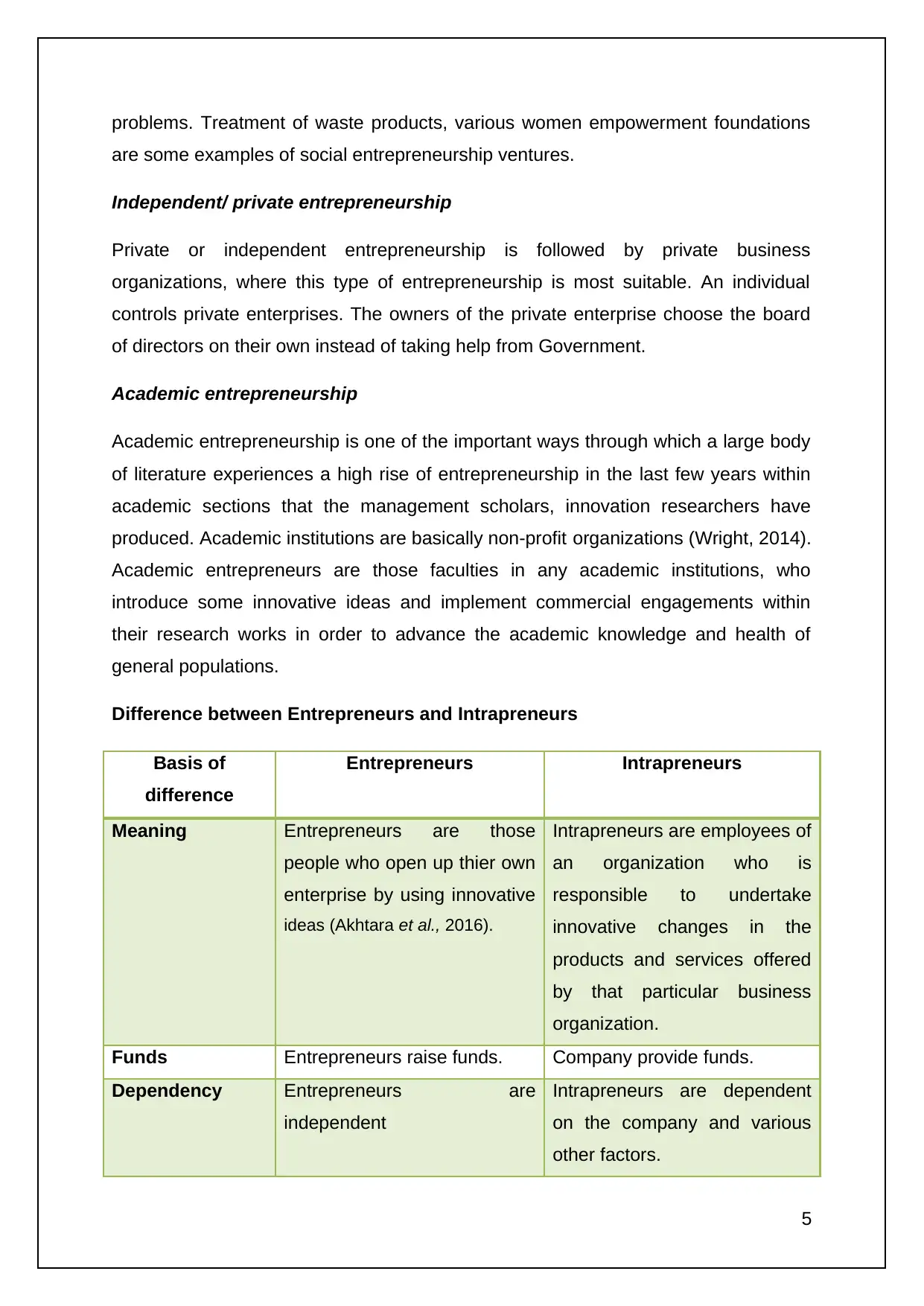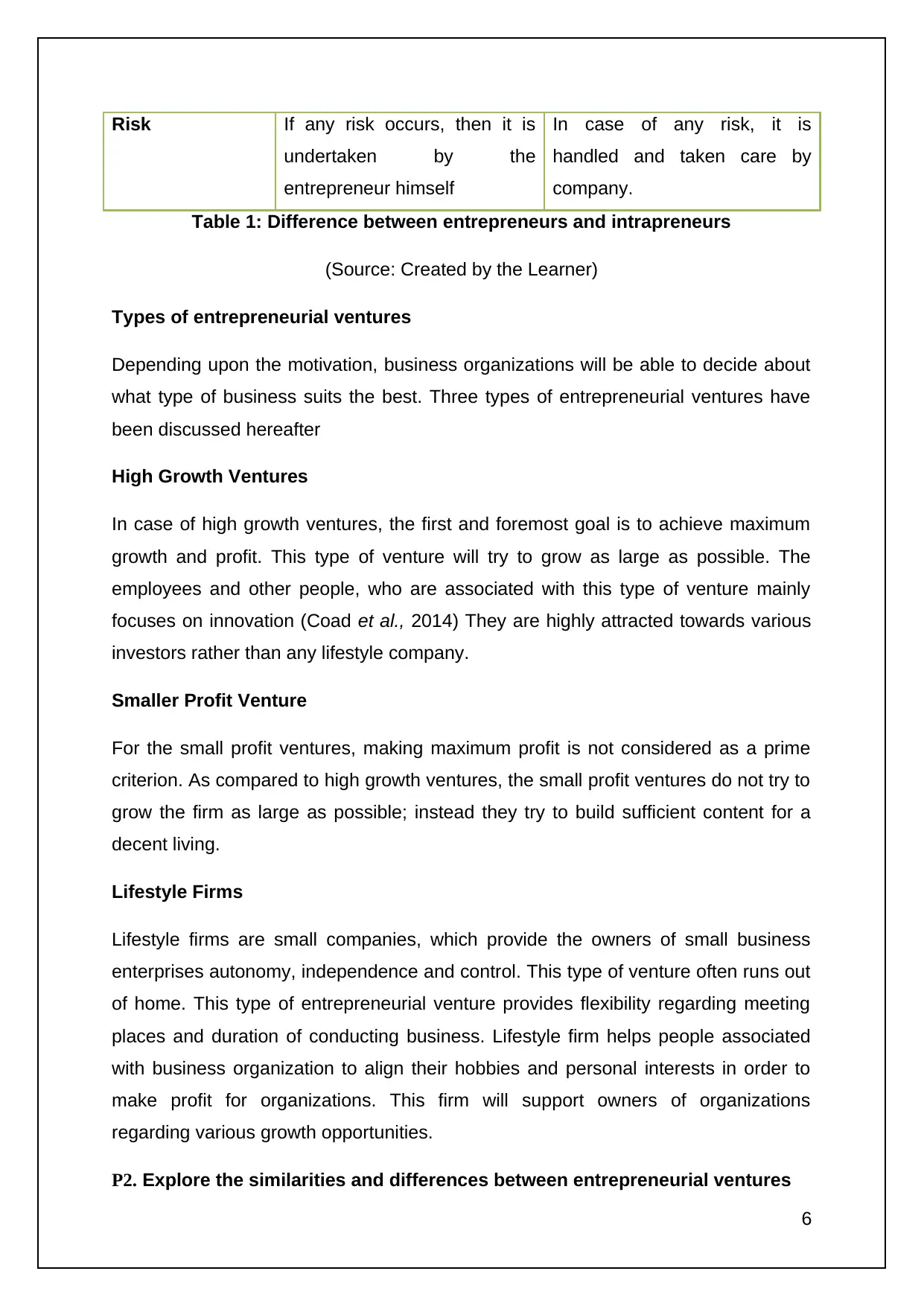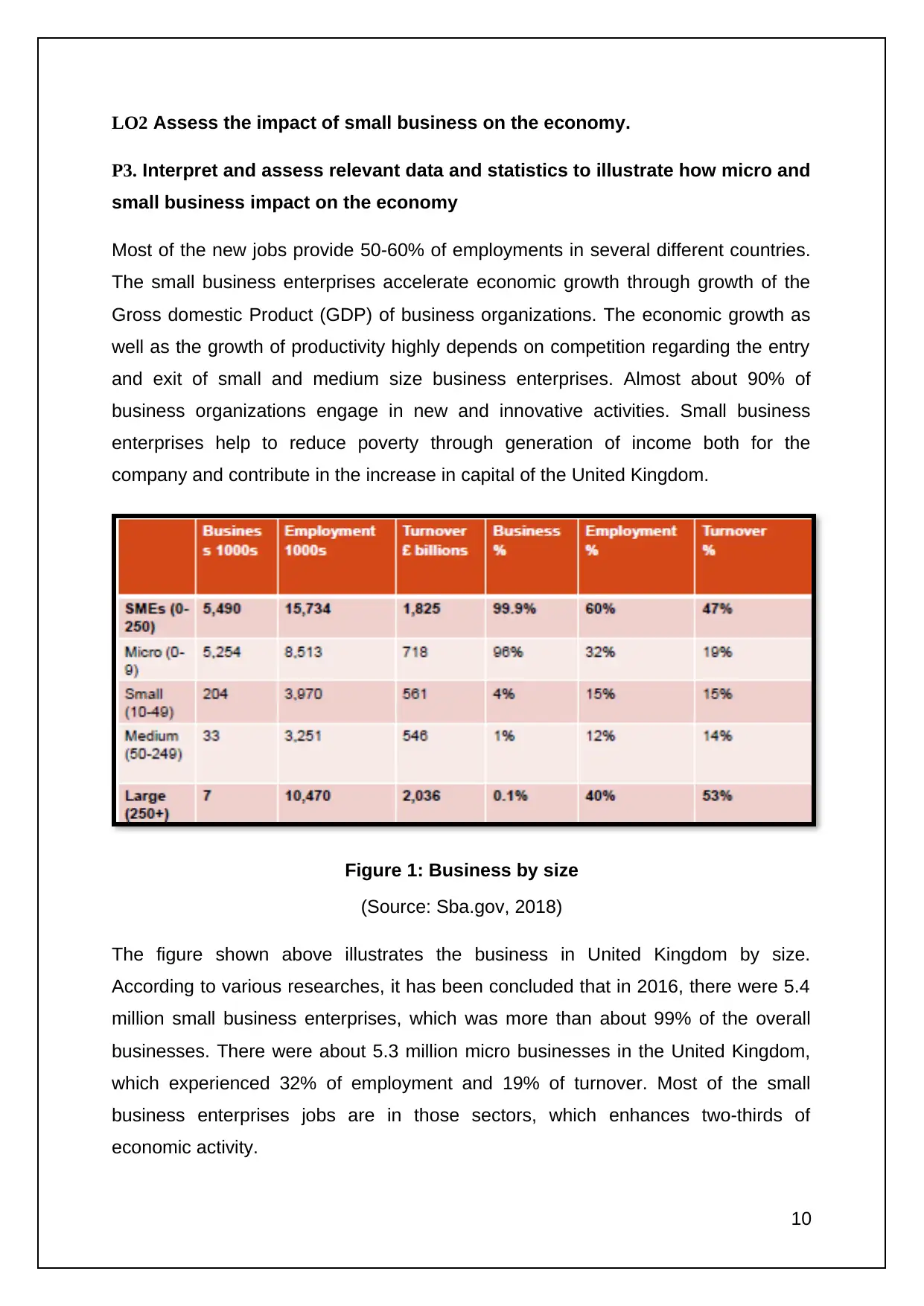Entrepreneurship and Small Business Management: Venture Types Impact
VerifiedAdded on 2024/06/03
|19
|4354
|237
Report
AI Summary
This report examines various entrepreneurial venture types, including public sector, corporate, social, private, and academic entrepreneurship, highlighting their similarities and differences. It assesses the impact of small businesses on the UK economy, using data and statistics to illustrate their contribution to employment, GDP growth, and innovation. The report also explains the importance of small businesses and startups to the growth of the social economy, emphasizing their role in job creation, income generation, and economic flexibility. It concludes by underscoring the significant contribution of small and medium-sized enterprises (SMEs) to the UK's economic productivity and overall revenue.

Entrepreneurship and Small Business Management
1
1
Paraphrase This Document
Need a fresh take? Get an instant paraphrase of this document with our AI Paraphraser

Table of Contents
Introduction...................................................................................................................3
LO1...............................................................................................................................4
P1..................................................................................................................................4
P2..................................................................................................................................6
LO2.............................................................................................................................10
P3................................................................................................................................10
P4................................................................................................................................11
LO3.............................................................................................................................13
P5................................................................................................................................13
P6................................................................................................................................14
LO4.............................................................................................................................16
P7................................................................................................................................16
Conclusion..................................................................................................................17
Reference List.............................................................................................................18
2
Introduction...................................................................................................................3
LO1...............................................................................................................................4
P1..................................................................................................................................4
P2..................................................................................................................................6
LO2.............................................................................................................................10
P3................................................................................................................................10
P4................................................................................................................................11
LO3.............................................................................................................................13
P5................................................................................................................................13
P6................................................................................................................................14
LO4.............................................................................................................................16
P7................................................................................................................................16
Conclusion..................................................................................................................17
Reference List.............................................................................................................18
2

Introduction
An entrepreneur is a person who works for his own self by introducing his own
venture rather than working as an employee for any other business organization.
Entrepreneur is an innovator who brings innovation within a venture by his new and
good ideas. In this project report, the researcher explored the range of venture types,
which are entrepreneurial. The learner has been approached by a small business
enterprise and thus the learner is required to help ‘Arcadia Group’ to introduce a new
business based in the United Kingdom. The prime objective of the business
organization is to diversify the products and services offered by the business
organization as a part of innovation. The researcher needs to assess the impact of
small business on the national economy. In this project report, the researchers will
identify several environmental factors. A detailed and critical analysis will be done
about how the environmental factors may foster or obstruct entrepreneurship.
3
An entrepreneur is a person who works for his own self by introducing his own
venture rather than working as an employee for any other business organization.
Entrepreneur is an innovator who brings innovation within a venture by his new and
good ideas. In this project report, the researcher explored the range of venture types,
which are entrepreneurial. The learner has been approached by a small business
enterprise and thus the learner is required to help ‘Arcadia Group’ to introduce a new
business based in the United Kingdom. The prime objective of the business
organization is to diversify the products and services offered by the business
organization as a part of innovation. The researcher needs to assess the impact of
small business on the national economy. In this project report, the researchers will
identify several environmental factors. A detailed and critical analysis will be done
about how the environmental factors may foster or obstruct entrepreneurship.
3
⊘ This is a preview!⊘
Do you want full access?
Subscribe today to unlock all pages.

Trusted by 1+ million students worldwide

LO1 Explore and illustrate the range of venture types that might be considered
entrepreneurial.
P1. Examine different types of entrepreneurial ventures and explain how they
relate to the typology of entrepreneurship
Entrepreneurship is an innovative thinking, which results in the creation of new and
innovative opportunities for an individual and an entire organization as a whole.
Generally, entrepreneurs are said to be the founders of any business enterprise,
which may be a small scale or large scale based business enterprise. Entrepreneurs
introduce change in products or services within an existing business organization
(Wennekers and van, 2017).
Types of entrepreneurship
Public sector entrepreneurship
Public sector entrepreneurship is a new area to open up a business venture. The
three factors, which help organizations to make up Public sector entrepreneurship,
are regulation, facilitations and economic factors (Leyden and Link, 2015).
Government often controls public sector enterprises. The Government of any nation
take final decision and have the final say about public sector business enterprises.
Corporate entrepreneurship
It is necessary for each company to have organic growth and thus organizations
follow certain techniques to sustain and support innovations and growth of the
organizations. Corporate entrepreneurship is used in order to develop new services
and products for existing or new business enterprises.
Social entrepreneurship
The type of entrepreneurship, which is required to recognize social values and
problems and achieve social change within a business organization, by
implementing certain entrepreneurial operations and through various principles and
processes are known as social entrepreneurship (Dees, 2017). Apart from social
problems, social entrepreneurship also emphasize on various environmental
4
entrepreneurial.
P1. Examine different types of entrepreneurial ventures and explain how they
relate to the typology of entrepreneurship
Entrepreneurship is an innovative thinking, which results in the creation of new and
innovative opportunities for an individual and an entire organization as a whole.
Generally, entrepreneurs are said to be the founders of any business enterprise,
which may be a small scale or large scale based business enterprise. Entrepreneurs
introduce change in products or services within an existing business organization
(Wennekers and van, 2017).
Types of entrepreneurship
Public sector entrepreneurship
Public sector entrepreneurship is a new area to open up a business venture. The
three factors, which help organizations to make up Public sector entrepreneurship,
are regulation, facilitations and economic factors (Leyden and Link, 2015).
Government often controls public sector enterprises. The Government of any nation
take final decision and have the final say about public sector business enterprises.
Corporate entrepreneurship
It is necessary for each company to have organic growth and thus organizations
follow certain techniques to sustain and support innovations and growth of the
organizations. Corporate entrepreneurship is used in order to develop new services
and products for existing or new business enterprises.
Social entrepreneurship
The type of entrepreneurship, which is required to recognize social values and
problems and achieve social change within a business organization, by
implementing certain entrepreneurial operations and through various principles and
processes are known as social entrepreneurship (Dees, 2017). Apart from social
problems, social entrepreneurship also emphasize on various environmental
4
Paraphrase This Document
Need a fresh take? Get an instant paraphrase of this document with our AI Paraphraser

problems. Treatment of waste products, various women empowerment foundations
are some examples of social entrepreneurship ventures.
Independent/ private entrepreneurship
Private or independent entrepreneurship is followed by private business
organizations, where this type of entrepreneurship is most suitable. An individual
controls private enterprises. The owners of the private enterprise choose the board
of directors on their own instead of taking help from Government.
Academic entrepreneurship
Academic entrepreneurship is one of the important ways through which a large body
of literature experiences a high rise of entrepreneurship in the last few years within
academic sections that the management scholars, innovation researchers have
produced. Academic institutions are basically non-profit organizations (Wright, 2014).
Academic entrepreneurs are those faculties in any academic institutions, who
introduce some innovative ideas and implement commercial engagements within
their research works in order to advance the academic knowledge and health of
general populations.
Difference between Entrepreneurs and Intrapreneurs
Basis of
difference
Entrepreneurs Intrapreneurs
Meaning Entrepreneurs are those
people who open up thier own
enterprise by using innovative
ideas (Akhtara et al., 2016).
Intrapreneurs are employees of
an organization who is
responsible to undertake
innovative changes in the
products and services offered
by that particular business
organization.
Funds Entrepreneurs raise funds. Company provide funds.
Dependency Entrepreneurs are
independent
Intrapreneurs are dependent
on the company and various
other factors.
5
are some examples of social entrepreneurship ventures.
Independent/ private entrepreneurship
Private or independent entrepreneurship is followed by private business
organizations, where this type of entrepreneurship is most suitable. An individual
controls private enterprises. The owners of the private enterprise choose the board
of directors on their own instead of taking help from Government.
Academic entrepreneurship
Academic entrepreneurship is one of the important ways through which a large body
of literature experiences a high rise of entrepreneurship in the last few years within
academic sections that the management scholars, innovation researchers have
produced. Academic institutions are basically non-profit organizations (Wright, 2014).
Academic entrepreneurs are those faculties in any academic institutions, who
introduce some innovative ideas and implement commercial engagements within
their research works in order to advance the academic knowledge and health of
general populations.
Difference between Entrepreneurs and Intrapreneurs
Basis of
difference
Entrepreneurs Intrapreneurs
Meaning Entrepreneurs are those
people who open up thier own
enterprise by using innovative
ideas (Akhtara et al., 2016).
Intrapreneurs are employees of
an organization who is
responsible to undertake
innovative changes in the
products and services offered
by that particular business
organization.
Funds Entrepreneurs raise funds. Company provide funds.
Dependency Entrepreneurs are
independent
Intrapreneurs are dependent
on the company and various
other factors.
5

Risk If any risk occurs, then it is
undertaken by the
entrepreneur himself
In case of any risk, it is
handled and taken care by
company.
Table 1: Difference between entrepreneurs and intrapreneurs
(Source: Created by the Learner)
Types of entrepreneurial ventures
Depending upon the motivation, business organizations will be able to decide about
what type of business suits the best. Three types of entrepreneurial ventures have
been discussed hereafter
High Growth Ventures
In case of high growth ventures, the first and foremost goal is to achieve maximum
growth and profit. This type of venture will try to grow as large as possible. The
employees and other people, who are associated with this type of venture mainly
focuses on innovation (Coad et al., 2014) They are highly attracted towards various
investors rather than any lifestyle company.
Smaller Profit Venture
For the small profit ventures, making maximum profit is not considered as a prime
criterion. As compared to high growth ventures, the small profit ventures do not try to
grow the firm as large as possible; instead they try to build sufficient content for a
decent living.
Lifestyle Firms
Lifestyle firms are small companies, which provide the owners of small business
enterprises autonomy, independence and control. This type of venture often runs out
of home. This type of entrepreneurial venture provides flexibility regarding meeting
places and duration of conducting business. Lifestyle firm helps people associated
with business organization to align their hobbies and personal interests in order to
make profit for organizations. This firm will support owners of organizations
regarding various growth opportunities.
P2. Explore the similarities and differences between entrepreneurial ventures
6
undertaken by the
entrepreneur himself
In case of any risk, it is
handled and taken care by
company.
Table 1: Difference between entrepreneurs and intrapreneurs
(Source: Created by the Learner)
Types of entrepreneurial ventures
Depending upon the motivation, business organizations will be able to decide about
what type of business suits the best. Three types of entrepreneurial ventures have
been discussed hereafter
High Growth Ventures
In case of high growth ventures, the first and foremost goal is to achieve maximum
growth and profit. This type of venture will try to grow as large as possible. The
employees and other people, who are associated with this type of venture mainly
focuses on innovation (Coad et al., 2014) They are highly attracted towards various
investors rather than any lifestyle company.
Smaller Profit Venture
For the small profit ventures, making maximum profit is not considered as a prime
criterion. As compared to high growth ventures, the small profit ventures do not try to
grow the firm as large as possible; instead they try to build sufficient content for a
decent living.
Lifestyle Firms
Lifestyle firms are small companies, which provide the owners of small business
enterprises autonomy, independence and control. This type of venture often runs out
of home. This type of entrepreneurial venture provides flexibility regarding meeting
places and duration of conducting business. Lifestyle firm helps people associated
with business organization to align their hobbies and personal interests in order to
make profit for organizations. This firm will support owners of organizations
regarding various growth opportunities.
P2. Explore the similarities and differences between entrepreneurial ventures
6
⊘ This is a preview!⊘
Do you want full access?
Subscribe today to unlock all pages.

Trusted by 1+ million students worldwide

Similarities between Public, private and social enterprise
Basis of
difference
Public enterprise Social enterprise Private enterprise
Roles The roles of public
enterprises are from
social perspectives.
In most of the
countries, public
enterprises are
socially desired but
the enterprises are
not economically
viable.
Public enterprises
play a very
important role to
maximize the human
welfare. The public
enterprises provide
a huge number of
employments to
people by both
direct and indirect
methods (Bös, 2014).
The basic
operations in public
sector enterprises
take place on behalf
of the Government.
Social enterprises
includes various
number of company
models, which
includes
cooperatives and
social mutual
organizations.
Social enterprises
put much more
emphasis on
innovation and
experimenting with
innovative ideas.
Social enterprises
can reach people,
who are socially
excluded.
Social enterprises
provide them with
certain opportunities
such as volunteering,
training and
employment
opportunities.
A private enterprise
is that type of
enterprise, which is
owned and
controlled by
private citizens.
Private enterprises
may vary from large
public trade
corporations to sole
ownerships.
Private enterprises
run and achieve
success and
maximum profit by
experiencing high
competition.
Competition helps
private enterprises
to promote
efficiency, which in
turn innovates and
helps to develop
private sector
business
organizations.
Characteristic
s
The public sector
enterprises raise the
capital from public
revenues like duty,
Social enterprises
adopt certain
missions, which
helps the enterprise
Private sector
businesses are
generally
established to
7
Basis of
difference
Public enterprise Social enterprise Private enterprise
Roles The roles of public
enterprises are from
social perspectives.
In most of the
countries, public
enterprises are
socially desired but
the enterprises are
not economically
viable.
Public enterprises
play a very
important role to
maximize the human
welfare. The public
enterprises provide
a huge number of
employments to
people by both
direct and indirect
methods (Bös, 2014).
The basic
operations in public
sector enterprises
take place on behalf
of the Government.
Social enterprises
includes various
number of company
models, which
includes
cooperatives and
social mutual
organizations.
Social enterprises
put much more
emphasis on
innovation and
experimenting with
innovative ideas.
Social enterprises
can reach people,
who are socially
excluded.
Social enterprises
provide them with
certain opportunities
such as volunteering,
training and
employment
opportunities.
A private enterprise
is that type of
enterprise, which is
owned and
controlled by
private citizens.
Private enterprises
may vary from large
public trade
corporations to sole
ownerships.
Private enterprises
run and achieve
success and
maximum profit by
experiencing high
competition.
Competition helps
private enterprises
to promote
efficiency, which in
turn innovates and
helps to develop
private sector
business
organizations.
Characteristic
s
The public sector
enterprises raise the
capital from public
revenues like duty,
Social enterprises
adopt certain
missions, which
helps the enterprise
Private sector
businesses are
generally
established to
7
Paraphrase This Document
Need a fresh take? Get an instant paraphrase of this document with our AI Paraphraser

tax, and penalty and
so on. Public
enterprises provide
certain benefits such
as retirements, job
security, allowances,
etc.
The public sector
enterprises provide
high job stability to
employees.
Public enterprises
are entirely
controlled by the
Government, may it
be central
Government or state
Government.
For the upliftment of
people, public
enterprises provides
certain opportunities
such as railway
services, postal
services and
facilities, health
facilities at low cost,
education facilities,
security purposes
and so on.
to create and sustain
not only private value
but also social
values.
Social enterprises
pursue new
opportunities to fulfill
missions. Employees
and all other people
who are associated
with social
enterprises, always
engage themselves
in a continuous
process of learning,
adaptation and
innovation. Social
enterprises give
missions much more
priority than profit.
make profit and
build brand image
and brand
reputation of
business
organizations.
In case of private
sector enterprises,
job stability is
always based on
the performance of
employees.
If performance of
employees are
good, then the
employee will be
promoted otherwise
the company may
terminate the
employee due to
underperformance.
Private sector
enterprises
provides certain
opportunities such
as
telecommunication
services,
information and
technology
services,
development of
infrastructure,
8
so on. Public
enterprises provide
certain benefits such
as retirements, job
security, allowances,
etc.
The public sector
enterprises provide
high job stability to
employees.
Public enterprises
are entirely
controlled by the
Government, may it
be central
Government or state
Government.
For the upliftment of
people, public
enterprises provides
certain opportunities
such as railway
services, postal
services and
facilities, health
facilities at low cost,
education facilities,
security purposes
and so on.
to create and sustain
not only private value
but also social
values.
Social enterprises
pursue new
opportunities to fulfill
missions. Employees
and all other people
who are associated
with social
enterprises, always
engage themselves
in a continuous
process of learning,
adaptation and
innovation. Social
enterprises give
missions much more
priority than profit.
make profit and
build brand image
and brand
reputation of
business
organizations.
In case of private
sector enterprises,
job stability is
always based on
the performance of
employees.
If performance of
employees are
good, then the
employee will be
promoted otherwise
the company may
terminate the
employee due to
underperformance.
Private sector
enterprises
provides certain
opportunities such
as
telecommunication
services,
information and
technology
services,
development of
infrastructure,
8

provides quality
education facilities
and so on.
Objectives The main objective
of the public
enterprise is to
serve the citizens of
country.
The main objectives
of social enterprises
are to maximize profit
both for owners and
for shareholders.
Social enterprises
have primarily social
and environmental
objectives.
The basic objective
of the private sector
enterprises is to
earn maximum
profit and growth
for private business
organizations.
Table 2: Similarities and differences between entrepreneurial ventures
(Source: Created by the Learner)
9
education facilities
and so on.
Objectives The main objective
of the public
enterprise is to
serve the citizens of
country.
The main objectives
of social enterprises
are to maximize profit
both for owners and
for shareholders.
Social enterprises
have primarily social
and environmental
objectives.
The basic objective
of the private sector
enterprises is to
earn maximum
profit and growth
for private business
organizations.
Table 2: Similarities and differences between entrepreneurial ventures
(Source: Created by the Learner)
9
⊘ This is a preview!⊘
Do you want full access?
Subscribe today to unlock all pages.

Trusted by 1+ million students worldwide

LO2 Assess the impact of small business on the economy.
P3. Interpret and assess relevant data and statistics to illustrate how micro and
small business impact on the economy
Most of the new jobs provide 50-60% of employments in several different countries.
The small business enterprises accelerate economic growth through growth of the
Gross domestic Product (GDP) of business organizations. The economic growth as
well as the growth of productivity highly depends on competition regarding the entry
and exit of small and medium size business enterprises. Almost about 90% of
business organizations engage in new and innovative activities. Small business
enterprises help to reduce poverty through generation of income both for the
company and contribute in the increase in capital of the United Kingdom.
Figure 1: Business by size
(Source: Sba.gov, 2018)
The figure shown above illustrates the business in United Kingdom by size.
According to various researches, it has been concluded that in 2016, there were 5.4
million small business enterprises, which was more than about 99% of the overall
businesses. There were about 5.3 million micro businesses in the United Kingdom,
which experienced 32% of employment and 19% of turnover. Most of the small
business enterprises jobs are in those sectors, which enhances two-thirds of
economic activity.
10
P3. Interpret and assess relevant data and statistics to illustrate how micro and
small business impact on the economy
Most of the new jobs provide 50-60% of employments in several different countries.
The small business enterprises accelerate economic growth through growth of the
Gross domestic Product (GDP) of business organizations. The economic growth as
well as the growth of productivity highly depends on competition regarding the entry
and exit of small and medium size business enterprises. Almost about 90% of
business organizations engage in new and innovative activities. Small business
enterprises help to reduce poverty through generation of income both for the
company and contribute in the increase in capital of the United Kingdom.
Figure 1: Business by size
(Source: Sba.gov, 2018)
The figure shown above illustrates the business in United Kingdom by size.
According to various researches, it has been concluded that in 2016, there were 5.4
million small business enterprises, which was more than about 99% of the overall
businesses. There were about 5.3 million micro businesses in the United Kingdom,
which experienced 32% of employment and 19% of turnover. Most of the small
business enterprises jobs are in those sectors, which enhances two-thirds of
economic activity.
10
Paraphrase This Document
Need a fresh take? Get an instant paraphrase of this document with our AI Paraphraser

Small businesses can be said as the backbone of the economy of the United
Kingdom. Small and medium sized enterprises provide a major role in increasing the
productivity and capital of the United Kingdom. The small and medium sized
business enterprises contribute about 47% of the total UK revenue.
Figure 2: Contribution of SME to UK economy as percentage of total business
GVA
(Source: Marketbusinessnews.com, 2018)
The above graphical representation illustrates the contribution of small and medium
sized business enterprises to the economy of United Kingdom as a percentage of
total business GVA. The graphical representation also provides information about
future prediction regarding the contribution of SME to the economic growth of the
country.
P4. Explain the importance of small businesses and business starts-ups to the
growth of social economy
11
Kingdom. Small and medium sized enterprises provide a major role in increasing the
productivity and capital of the United Kingdom. The small and medium sized
business enterprises contribute about 47% of the total UK revenue.
Figure 2: Contribution of SME to UK economy as percentage of total business
GVA
(Source: Marketbusinessnews.com, 2018)
The above graphical representation illustrates the contribution of small and medium
sized business enterprises to the economy of United Kingdom as a percentage of
total business GVA. The graphical representation also provides information about
future prediction regarding the contribution of SME to the economic growth of the
country.
P4. Explain the importance of small businesses and business starts-ups to the
growth of social economy
11

Small and medium size enterprises are a huge source of innovation in the economy.
SME’s are one of the important sources in exporting revenues in some developing
countries. Small business entrepreneurs have received huge recognition as they
have driven economic growth largely. Through various researches, it can be
concluded that small and medium sized business enterprises are crucial for
economic growth and introduces innovation in various fields. Larger firms start the
business as small business enterprises and they grow larger by expanding business
activities (Mikic et al., 2016). Small and medium sized enterprises emphasizes on
more labour-intensive process of production as compared to larger enterprises. The
SME’s provides a huge provision for productive development and income
generation. SME’s also contributes in employment in the private sector companies.
Small and medium scale enterprises provide flexibility in the economy of United
Kingdom.
The enterprises provide efficient resource allocation both from environmental and
social perspectives. Small and medium sized enterprises are considered as the
engine room of economy. From various researches, it has been concluded that
among the total contribution, SME’s contributes the maximum revenue. These firms
employ about 250 employees. According to reports, SME’s have captured a vast
area of private sectors of United Kingdom. The top ten cities of the United Kingdom,
which adds value to the economy of the nation are London, Birmingham,
Manchester, Leeds, Bristol, Sheffield, Cardiff, Glasgow, Tyneside and so on. The
cities that are mentioned above, contribute a huge portion of the revenue in the UK
economy. Through some of the researches, it is revealed that the size of SME added
value in the economy of the United Kingdom and it will increase further in the coming
years. Small business helps to transform and helps to develop the communities.
12
SME’s are one of the important sources in exporting revenues in some developing
countries. Small business entrepreneurs have received huge recognition as they
have driven economic growth largely. Through various researches, it can be
concluded that small and medium sized business enterprises are crucial for
economic growth and introduces innovation in various fields. Larger firms start the
business as small business enterprises and they grow larger by expanding business
activities (Mikic et al., 2016). Small and medium sized enterprises emphasizes on
more labour-intensive process of production as compared to larger enterprises. The
SME’s provides a huge provision for productive development and income
generation. SME’s also contributes in employment in the private sector companies.
Small and medium scale enterprises provide flexibility in the economy of United
Kingdom.
The enterprises provide efficient resource allocation both from environmental and
social perspectives. Small and medium sized enterprises are considered as the
engine room of economy. From various researches, it has been concluded that
among the total contribution, SME’s contributes the maximum revenue. These firms
employ about 250 employees. According to reports, SME’s have captured a vast
area of private sectors of United Kingdom. The top ten cities of the United Kingdom,
which adds value to the economy of the nation are London, Birmingham,
Manchester, Leeds, Bristol, Sheffield, Cardiff, Glasgow, Tyneside and so on. The
cities that are mentioned above, contribute a huge portion of the revenue in the UK
economy. Through some of the researches, it is revealed that the size of SME added
value in the economy of the United Kingdom and it will increase further in the coming
years. Small business helps to transform and helps to develop the communities.
12
⊘ This is a preview!⊘
Do you want full access?
Subscribe today to unlock all pages.

Trusted by 1+ million students worldwide
1 out of 19
Related Documents
Your All-in-One AI-Powered Toolkit for Academic Success.
+13062052269
info@desklib.com
Available 24*7 on WhatsApp / Email
![[object Object]](/_next/static/media/star-bottom.7253800d.svg)
Unlock your academic potential
Copyright © 2020–2025 A2Z Services. All Rights Reserved. Developed and managed by ZUCOL.



